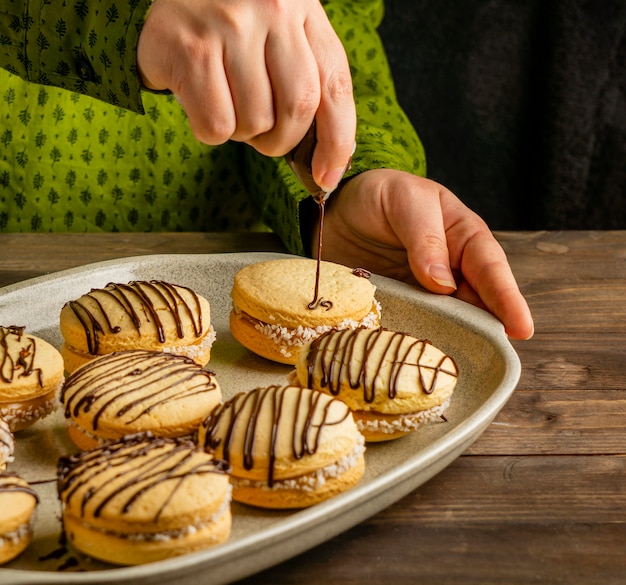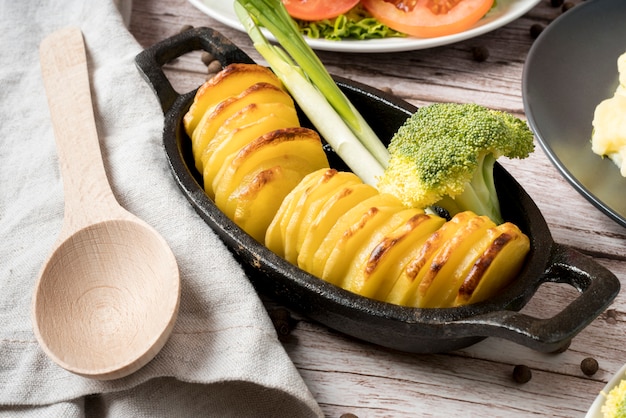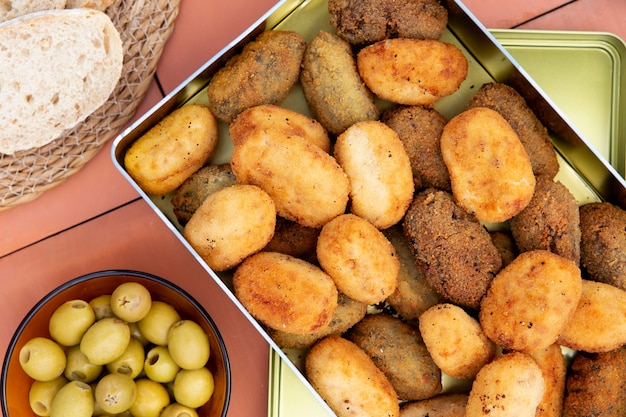Let me tell you, there’s nothing quite like a perfectly baked potato. The fluffy, steaming interior, the crispy golden skin – it’s a simple pleasure that never gets old. But finding that sweet spot for cooking time can be tricky, especially when you’re dealing with different potato types and oven quirks. I’ve definitely had my fair share of disappointments, staring at a stubbornly uncooked potato, wondering where I went wrong.
Through trial and error, and a bit of kitchen science, I’ve finally cracked the code for achieving consistently perfect baked potatoes at 350 degrees fahrenheit. Whether you're a seasoned baker or a kitchen newbie, this guide will equip you with the knowledge and tips to make every baked potato a triumph.
(Part 1) The Foundation of a Perfect Bake

choosing the right potato
The first step is picking the right potato. You want one that’s got a good amount of starch, which gives you that fluffy, melt-in-your-mouth texture. Now, you might think any potato will do, but trust me, some are better than others for baking. My top choice? russet potatoes – they’re the baking superstars! They’re known for their high starch content and hold their shape beautifully as they bake. It’s like they were born for this role.
But don’t be afraid to venture beyond the Russets! yukon gold potatoes, with their slightly sweet flavor and a little more moisture, can create a delightful baked potato experience. And then there’s the starchy, firm texture of red potatoes – they’re a great option for those who prefer a firmer bite. Just remember, cooking times might vary depending on the potato variety.
The Importance of Size
Imagine baking a giant potato alongside a tiny one. The giant takes ages, while the tiny one might be done before you know it! That's why choosing potatoes that are similar in size is essential for even cooking. Aim for potatoes that are around 3 to 4 inches in diameter. If you have some larger potatoes, you can always cut them in half to help them cook more evenly.
The Temperature Tango: Why 350 Degrees is the Sweet Spot
Let's talk oven temperature. You might think cranking up the heat will speed things up, but that’s not always the case. High heat can lead to uneven cooking, a dry exterior, and even burnt bits. 350 degrees Fahrenheit (175 degrees Celsius) is the Goldilocks temperature for baking potatoes – it’s just right! It allows for even cooking without drying the potato out, ensuring that fluffy, moist interior we all crave.
(Part 2) Prepping for Success

Scrub, Prick, and Oil: A Three-Step Routine
First, give those potatoes a good scrub! Don’t be shy, get rid of any dirt or debris. Next, comes the pricking – use a fork to poke a few holes in each potato. This is crucial! It allows steam to escape during baking, preventing those dreaded potato explosions.
And finally, a light coating of oil. A drizzle of olive oil or vegetable oil can create a crispy skin and help to keep the potato moist. It also helps to prevent sticking to the baking sheet. Don’t go overboard, just a light sheen is all you need.
The Great Wrap Debate: Foil or No Foil?
Ah, the age-old question! Foil or no foil? Some swear by the foil wrap method, claiming it retains moisture and creates a more even bake. Others prefer to bake uncovered, saying it yields a crispier skin. I’m a bit of a hybrid baker – I like to wrap my potatoes for the first part of the baking process, then unwrap them for the last 15 minutes or so to get that perfect golden-brown crust. It’s a balancing act, but totally worth the effort.
(Part 3) Time, Temperature, and Timing It Right

Understanding Baking Time
Here’s where the fun begins – figuring out how long to bake those potatoes. The size of your potatoes plays a big role. As a general rule, here's a guide:
| Size (inches) | Baking Time (minutes) |
|---|---|
| 2-3 inches | 45-55 minutes |
| 3-4 inches | 60-75 minutes |
| 4-5 inches | 75-90 minutes |
But remember, these are just guidelines. Always check for doneness using a fork. The potato should be tender and easily pierced. If it’s still resistant, pop it back in the oven for a few more minutes.
The Art of Checking for Doneness
Don’t just set a timer and walk away! Every oven is unique, and potatoes can have their own personalities. The best way to check for doneness is to insert a fork into the thickest part of the potato. If it slides in easily, you’re in business! If it feels firm, give it a few more minutes in the oven. You want that fluffy, yielding texture, not a tough and uncooked center.
Avoiding Overbaking: The Dangers of a Dry Potato
Overbaked potatoes are a sad sight – they become dry, crumbly, and lack that delicious fluffy interior. Once your potatoes are cooked through, remove them from the oven and let them cool slightly before serving. They’ll continue to cook a bit more as they cool, so don’t rush the process.
(Part 4) Mastering Your Oven: Calibrating for Consistency
Oven Variations: Every Oven Has a Personality
Each oven has its own quirks, just like people. Some run hotter, some run cooler, and this can affect your baking times. Calibrating your oven is essential for ensuring consistent results. Use an oven thermometer – place it in the center of the oven rack, preheat to 350 degrees Fahrenheit, and check the temperature. If it reads 350 degrees, you’re good to go. If not, adjust the oven temperature accordingly.
Don’t Overcrowd the Oven: Give Those Potatoes Some Breathing Room
A cramped oven is a recipe for uneven cooking. Potatoes need space to breathe and cook evenly. Spread them out in a single layer on the baking sheet – don’t pile them on top of each other. This will ensure they cook evenly and don’t steam each other, which can lead to a soggy skin.
(Part 5) Techniques for Perfect Potatoes: Beyond the Basics
The Foil Wrap Method: For Extra Moisture and Fluffy Goodness
For those who crave an extra fluffy and moist potato, the foil wrap method is your best friend. It creates a steamy environment that cooks the potato evenly and prevents it from drying out. Simply wrap each potato in a piece of foil, fold it over, and crimp the edges to seal it. Bake for the recommended time, then remove the foil for the last 15 minutes to allow the skin to crisp up. This is particularly helpful for larger potatoes that need a little extra time.
The Salt Bake Method: A Flavorful and Crispy Twist
This is a little trick I learned from my grandmother, and it’s a game-changer for flavor! Before baking, sprinkle a generous amount of salt onto the baking sheet. This creates a salty crust around the potatoes, adding a delicious depth of flavor. The salt also helps to draw out moisture and create a crispier skin. Just remember, a little salt goes a long way – don’t go overboard!
(Part 6) Topping Your Creation: A Canvas for Culinary Creativity
Classic Choices: Butter, Sour Cream, and Cheese, Oh My!
Now comes the fun part: toppings! A baked potato is a blank canvas for culinary creativity. You can’t go wrong with the classic combo of butter, sour cream, and cheese. Add a sprinkle of chives or bacon bits for a touch of extra flavour.
Beyond the Classics: Adventures in Flavor
But don’t stop there! For something a bit more adventurous, try topping your baked potato with chili, pulled pork, or a simple salad. A dollop of salsa, guacamole, or pico de gallo can add a burst of freshness. Let your imagination run wild and experiment with different flavour combinations. The possibilities are endless!
(Part 7) A Few Tips and Tricks: Shortcuts and Leftover Solutions
The Microwave Shortcut: For When You Need a Quick Fix
If you’re in a pinch and need a baked potato in a hurry, the microwave can be your saviour. Microwave your potatoes for 5 to 7 minutes before transferring them to the oven. This will significantly reduce your overall baking time. Just be careful, as microwaved potatoes can be more prone to bursting, so keep a close eye on them.
Reheating Leftovers: No Waste, No Fuss
Leftover baked potatoes are a delicious and convenient meal. You can reheat them in the oven, microwave, or even in a toaster oven. If reheating in the oven, wrap them in foil to prevent them from drying out. For the microwave, cover them with a damp paper towel to retain moisture.
(Part 8) FAQs: Answering Your Baking Questions
1. Why do my baked potatoes sometimes explode in the oven?
This happens when steam builds up inside the potato without a way to escape. Pricking the potato with a fork before baking allows steam to vent, preventing explosions. Ensure the holes are deep enough to reach the center of the potato.
2. Can I bake potatoes in a slow cooker?
Absolutely! Slow cookers are fantastic for cooking potatoes evenly and slowly. Place your potatoes in the slow cooker and cook them on low for 4-6 hours, or on high for 2-3 hours. You can even add a bit of butter or oil for extra flavor.
3. How do I know if a baked potato is cooked through?
Insert a fork into the thickest part of the potato. If it slides in easily with little resistance, it’s cooked through. If it feels firm, give it a few more minutes in the oven.
4. Can I freeze baked potatoes?
Yes, you can freeze cooked baked potatoes. Let them cool completely, then wrap them individually in plastic wrap and place them in a freezer-safe bag. They’ll keep in the freezer for up to 3 months. To reheat, thaw the potato in the refrigerator overnight, then bake it in a preheated oven at 350 degrees Fahrenheit for about 30 minutes. You can also reheat frozen potatoes in the microwave – just make sure to pierce them with a fork first to prevent explosions.
5. What are some healthy toppings for baked potatoes?
There are many healthy toppings for baked potatoes. Try topping them with black beans, salsa, guacamole, grilled chicken, or a simple salad with vinaigrette dressing. Avoid high-fat toppings like sour cream and cheese and opt for low-fat alternatives or fresh toppings instead. Remember, baked potatoes themselves are a good source of fibre and potassium, making them a healthy addition to your diet.
I hope this guide has demystified the world of baked potato perfection! It’s a simple dish, but mastering the art of baking a perfect potato is a culinary achievement in itself. So go ahead, experiment with different toppings, and revel in the deliciousness of this humble yet satisfying side dish. Happy baking!
Everyone is watching

Perfect Rice Every Time: The Ultimate Guide to Cooking Rice
Cooking TipsAs a self-proclaimed foodie, I've always been a bit obsessed with rice. It's the foundation of countless cuisi...

Prime Rib Roast Cooking Time Chart: Per Pound Guide
Cooking TipsPrime rib roast. Just the name conjures images of lavish dinners, crackling fires, and hearty laughter. It’s ...

The Ultimate Guide to Cooking Asparagus: Tips, Techniques, and Recipes
Cooking TipsAsparagus. The mere mention of this spring delicacy conjures up images of vibrant green spears, crisp and burs...

Ultimate Guide to Cooking the Perfect Thanksgiving Turkey
Cooking TipsThanksgiving. Just the word conjures up images of overflowing tables laden with delicious food, the scent of r...

How Long to Bake Potatoes in the Oven (Perfect Every Time)
Cooking TipsBaked potatoes are a staple in my kitchen. They're incredibly versatile, delicious, and surprisingly easy to m...
